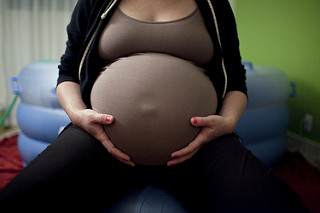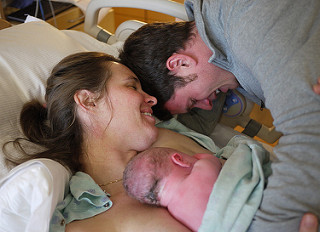Techniques for Pain Relief during Childbirth

Just thinking about childbirth can be enough to give anyone a fright. The pain is as real as it is intense. But the good news is that your body can overcome it with the help of certain techniques that provide pain relief during childbirth and improve dilation.
My mother always told me that during childbirth, “you feel only one pain.” What she meant by this was that, in her experience at least, she felt an intense pain which passed by quickly.
Although every childbirth story is valid, experts say that childbirth involves two stages, each associated with a different a type of pain.
The first type comes during the period of dilation, characterized by visceral pain. Its intensity is directly related to the pressure caused by your contractions.
The second is the period of labor. Contractions are coupled with severe, localized somatic pain. This is caused by the baby’s head pressing on the pelvic structure, according to a birth protocol prepared by the Spanish Society of Gynecology and Obstetrics (SEGO).
How to relieve pain during childbirth
This document explains that there are both pharmacological and non-pharmacological methods for pain relief during childbirth.
Non-pharmacological methods proven to be effective:
- Support from a birthing partner
- Dermal injection of sterile serum
- Immersion in water
Non-pharmacological methods without conclusive evidence:
- Psycho-prophylaxis
- Hypnosis
- Acupuncture
Effective pharmacological methods:
- Inhalation anesthesia
- Parenteral pain relief (intramuscular or intravenous)
- Spinal block (epidural and subarachnoid)
- General anesthesia
Before explaining some of the techniques for pain relief during childbirth, let’s look at some ways to promote dilation. This information comes from academic documents such as SEGO’s Medical Care Guide for Normal Birth.

Dilation techniques
Increasingly frequent and intense contractions are usually the first sign that labor has begun. Thanks to these contractions, you will be paying attention to what is happening, and will be able to make the decisions that are best for you.
The contractions will become rhythmic and painful, as your cervix gradually thins out, softens and dilates.
During the process of dilation, experts advise moving around instead of lying down. During the period of dilation, you can get into any position you find comfortable.
It is also beneficial to drink clear liquids (water, strained juices, tea or coffee or isotonic drinks). Isotonic drinks can be best, because in addition to hydrating you, they provide you with small quantities of glucose, preventing ketosis.
Some positions which may be comfortable and help you to avoid lying still on your back include standing up, squatting, sitting or lying on your side. These positions are associated with shorter labor times.
Additionally, women who adopt a kneeling position find that this is the most comfortable way to give birth, and report lower levels of lumbar and perineal pain after labor, according to the guide for normal births.
Other advice includes applying warm compresses to the perineum during labor and avoiding perineal massage, as well as pushing spontaneously.

Pain relief during childbirth
One of the most effective non-pharmacological methods for pain management is having support from a birthing partner. This might seem like a hippy technique, but in fact, it is scientifically proven.
Following the Cochrane Review, published in 2006, continuous support for women in labor must be considered an effective option for pain relief during childbirth. This review looked at 15 studies covering a total of 12,791 women.
One of the main conclusions is that women who received continuous support from a birthing partner had less need for analgesia and were more satisfied with their birthing experience. They also had fewer instrumental deliveries.
Having company during childbirth gives a sense of security, makes the pain of contractions more bearable and facilitates delivery. You must choose the person accompanying you during labor carefully, however.
Your birthing partner will need to know how you would like to give birth, and should be able to provide care, support and encouragement every step of the way. They should not be someone who will get too nervous or feel overwhelmed by the emotional significance of the moment.
One of the non-pharmacological methods that has not yet been conclusively proven to be effective is acupuncture. However, numerous studies have highlighted the benefits of acupuncture for pain relief during childbirth, with 63% effectiveness and up to a 94% reduction in the need for other forms of analgesia.
Spinal analgesia: epidural and intradural
One of most effective pharmacological methods for pain relief during childbirth is spinal analgesia. This provides pain relief throughout labor and delivery.
It has a stronger effect than any other systemic analgesic, and it is extremely safe. It is therefore the most common method for pain relief during childbirth, and should be available to all women going into labor.
Specialists say that this type of analgesia should be given on demand, as long as there are no counter-indications, given that it is the safest and most effective way of relieving pain during childbirth.
In certain situations, it also provides benefits that other types of analgesia cannot. In these cases, it is highly recommended, and the obstetrician should provide information so that the woman can make the right decision.
Epidural analgesia is the most widely studied and commonly available form of pain relief during childbirth. However, if you do opt for an epidural, you won’t be able to feel your contractions, so you will have to be told when to push.
This text is provided for informational purposes only and does not replace consultation with a professional. If in doubt, consult your specialist.
